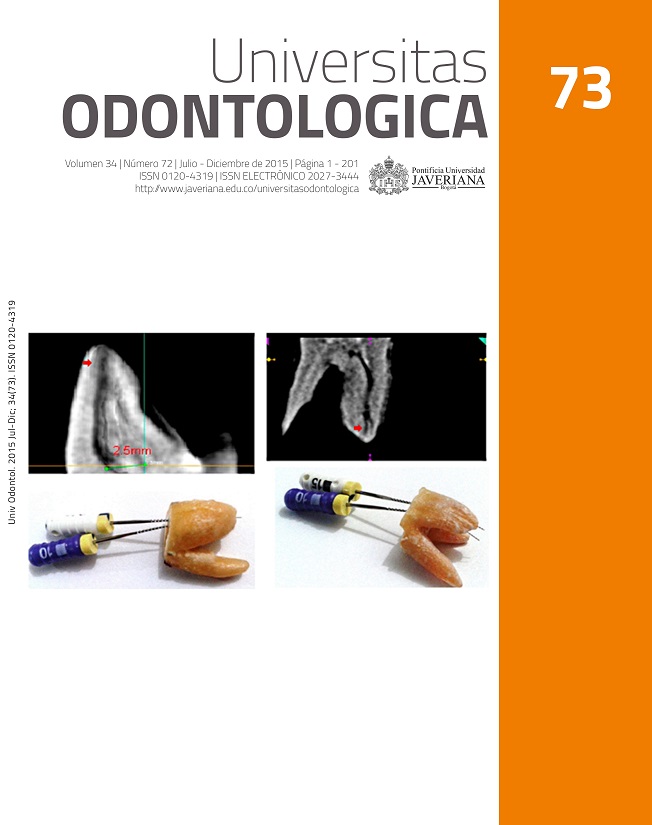Abstract
RESUMEN. Antecedentes: Es importante en la práctica clínica que los instrumentos rotatorios usados estén estériles para evitar infecciones cruzadas. Objetivo: Evaluar la efectividad del proceso de esterilización de las limas primarias WaveOne® con el propósito de fundamentar su reutilización. Métodos: Se evaluaron 50 limas primarias WaveOne®, 10 nuevas y 40 usadas en conductos mesovestibulares de molares con diagnóstico de periodontitis apical y necrosis pulpar. Las limas usadas se esterilizaron mediante la prueba de esterilidad establecida por la farmacopea 35 europea y japonesa. Resultados: Las 10 limas WaveOne® primarias, sin uso, no mostraron crecimiento de microorganismos. En el grupo 2, las 40 limas WaveOne® primarias usadas una vez y esterilizadas tampoco mostraron crecimiento de microorganismos. Conclusiones: El proceso de esterilización de las limas primarias WaveOne® fue satisfactorio. Además las limas primarias WaveOne®, como lo indica el fabricante, vienen estériles en su empaque.
ABSTRACT. Background: It is important that rotary instruments used in clinical practice are sterile to avoid cross-infection. Objective: To evaluate the effectiveness of the sterilization process of Primary WaveOne® files, in order to support their reutilization. Methods: The sample consisted of 50 Primary WaveOne® files, 10 new and 40 used to prepare mesio-vestibular root canals of molars with diagnosis of pulp necrosis or apical periodontitis. Files in group 2 were sterilized and tested through the protocol described at the European and Japanese Pharmacopoeia 35. Results: The 10 new Primary WaveOne® files did not show microorganism growth. The 40 sterilized files of group 2 did not show growth of microorganisms either. Conclusions: The process of file sterilization was effective. In addition, WaveOne® Primary files, as indicated by the manufacturer, come in sterile packaging.
Pinheiro E, Gomes B, Ferraz C, Sousa E, Teixeira F, Souza F. Microorganisms from canals of root-filled teeth with periapical lesions. Int Endod J. 2003; 36(1): 1-11.
Todd P, Whitney S, Walker S, Friedman S. Microbial contamination of endodontic files received from the manufacturer. J Endod. 2006; 32(7): 649-51.
Linsuwanont P, Parashos P, Messer H. Cleaning of rotary nickel-titanium endodontic instruments. Int Endod J. 2001; 37: 19-28.
Johnson M, Primack P, Loushine R, Craft D. Cleaning of endodontic files, part I: the effect of bioburden on the sterilization of endodontic files. J Endod. 1997; 23(1): 32-4.
Parashos P, Linsuwanont P, Messer HH. A cleaning protocol for rotary nickel-titanium endodontic instruments. Aust Dent J. 2004; 49(1): 20-7.
Aasim S, Mellor A. The effect of pre-soaking and time in the ultrasonic cleaner on the cleanliness of sterilized endodontic files. Int Endod J. 2006; 39: 143-9.
Dentsply India. Products. Weybridge, UK: Dentsply IH Ltd.; 2014. Consultado: marzo 2014. Disponible en línea en: http://dentsply.co.in/catalog/wave%E2%80%A2one%E2%84%A2-file.
Berutti E, Chiandussi G, Paolino D. Canal shaping with WaveOne primary reciprocating files and Protaper system: a comparative study. J Endod. 2012, 38(4): 505-9.
Wave One- Endodoncia- Sistema reciprocante de lima única. Dental Tv Web; 2010. Consultado: marzo 2014. Disponible en línea en: http://www.dentaltvweb.com/producto/wave-one-endodoncia-sistema-reciprocante-de-lima-unica.
Berutti E. Root Canal Anatomy preservation of WaveOne reciprocating files with or without glide path. J Endod. 2012; 38(1): 101-4.
Berutti E, Chiandussi G. Effect of canal length and curvature on working length alteration with WaveOne reciprocating files. J Endod. 2011; 37(12): 1687-90.
The U.S. Pharmacopeial Convention. USP 35-NF 30. United States Pharmacopeial and the National Formulary. 2012. Disponible en línea en: http://www.usp.org/.
Parirok H, Asgary S, Eghbal MJ. An energy dispersive X-ray analysis and SEM study of debris remaining on endodontic instruments after ultrasonic cleaning and autoclave sterilization. Aust Dent J. 2005; 31(2): 53-8.
Smith A, Lettersa S, Langeb A, Perrettc D, McHugha S, Bagga J. Residual protein levels on reprocessed dental instruments. J Hosp Infect. 2005; 61: 237-41.
Sonntag D, Ove A. Effect of prion decontamination protocols on nickel-titanium rotary surfaces. J Endod. 2007; 33(4): 442-6.
Venkatasubramanian R, Jayanthi, Das U, Bhatnagar S. Comparison of the effectiveness of sterilizing endodontic files by 4 different methods: An in vitro study. J Indian Soc Pedod Prev Dent. 2010; 28(1): 2-5.
Van Eldik D, Zilm PS, Rogers AH, Marin PD. A SEM evaluation of debris removal from endodontic files after cleaning and steam sterilization procedures. Aust Dent J. 2004; 49(3): 128-35.
Bourvis N, Boelle P, Cesbron J, Valleron A. Risk assessment of transmission of sporadic Creutzfeldt-Jakob disease in endodontic practice in absence of adequate prion inactivation. PLoS ONE. 2007; 12: 13-30.
Lemmer K, Mielke K, Georg P, Beekes M. Decontamination of surgical instruments from prion proteins: in vitro studies on the detachment, destabilization and degradation of PrPSc bound to steel surfaces. J Gen Virol. 2004; 85: 3805-16.
This journal is registered under a Creative Commons Attribution 4.0 International Public License. Thus, this work may be reproduced, distributed, and publicly shared in digital format, as long as the names of the authors and Pontificia Universidad Javeriana are acknowledged. Others are allowed to quote, adapt, transform, auto-archive, republish, and create based on this material, for any purpose (even commercial ones), provided the authorship is duly acknowledged, a link to the original work is provided, and it is specified if changes have been made. Pontificia Universidad Javeriana does not hold the rights of published works and the authors are solely responsible for the contents of their works; they keep the moral, intellectual, privacy, and publicity rights.
Approving the intervention of the work (review, copy-editing, translation, layout) and the following outreach, are granted through an use license and not through an assignment of rights. This means the journal and Pontificia Universidad Javeriana cannot be held responsible for any ethical malpractice by the authors. As a consequence of the protection granted by the use license, the journal is not required to publish recantations or modify information already published, unless the errata stems from the editorial management process. Publishing contents in this journal does not generate royalties for contributors.


